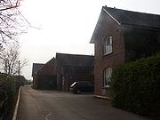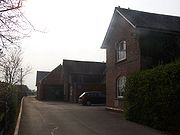
Stalmine
Encyclopedia
Stalmine is a village within the Wyre
borough of Lancashire
, England, in a part of the Fylde
known as Over Wyre
. The village is located on a small hill on the A588
, the main road between Hambleton
and Lancaster
, with the highest level 75ft above sea level. The village name has been spelt Stalmin (in 1205) and Stalemynne (in 1278).
containing the village is Stalmine-with-Staynall, which was listed as a township in the parish of Lancaster in 1835. The parish has six parish councillors.
held it as part of his Preston Fee. The first recorded possessor was Robert de Stalmine in 1165. The chapel of Stalmine was first mentioned about 1200 and a cemetery was consecrated in 1230. The chapel was rebuilt in 1806 when it was renamed St James. In 1689 Stalmine had a Presbyterian meeting house, which in 1717 was stated to be located "very near to the chapel".

) on Hallgate Lane, has a sundial
dated 1690. The village has one pub (the Seven Stars), which is located at the top of the hill in the village, and one school, Stalmine County Primary School. Stalmine Hall Residential Park is located near the church, in the grounds of the 19th century Stalmine Hall.
 The village is home to the amateur football club Wyre Villa, who play in the West Lancashire League
The village is home to the amateur football club Wyre Villa, who play in the West Lancashire League
, part of the English football league system
. They play their home games at Hall Gate Park on the edge of the village. The most successful season in the club's history to date was in 1996-97 when they were West Lancashire League champions.
Wyre
Wyre is a local government district with borough status in Lancashire, England. Its council is based in Poulton-le-Fylde.The district is named after the River Wyre, which runs through the district...
borough of Lancashire
Lancashire
Lancashire is a non-metropolitan county of historic origin in the North West of England. It takes its name from the city of Lancaster, and is sometimes known as the County of Lancaster. Although Lancaster is still considered to be the county town, Lancashire County Council is based in Preston...
, England, in a part of the Fylde
The Fylde
The Fylde ; Scandinavian: "field") is a coastal plain in western Lancashire, England. It is roughly a 13-mile square-shaped peninsula, bounded by Morecambe Bay to the north, the Ribble estuary to the south, the Irish Sea to the west, and the Bowland hills to the east...
known as Over Wyre
Over Wyre
Over Wyre is the collective name given to a group of villages in Lancashire, England, situated on the Fylde, to the north of the River Wyre. The group is usually considered to include Hambleton, Stalmine, Knott End-on-Sea, Preesall, Pilling and Out Rawcliffe...
. The village is located on a small hill on the A588
A588 road
The A588 is a road in England, which runs from Poulton-le-Fylde to Lancaster in Lancashire. It is the primary route serving the Over Wyre areas of the Fylde....
, the main road between Hambleton
Hambleton
Hambleton is a local government district of North Yorkshire, England. The main town and administrative centre is Northallerton, and includes the market towns and major villages of Bedale, Thirsk, Great Ayton, Stokesley and Easingwold....
and Lancaster
Lancaster, Lancashire
Lancaster is the county town of Lancashire, England. It is situated on the River Lune and has a population of 45,952. Lancaster is a constituent settlement of the wider City of Lancaster, local government district which has a population of 133,914 and encompasses several outlying towns, including...
, with the highest level 75ft above sea level. The village name has been spelt Stalmin (in 1205) and Stalemynne (in 1278).
Governance
The civil parishCivil parish
In England, a civil parish is a territorial designation and, where they are found, the lowest tier of local government below districts and counties...
containing the village is Stalmine-with-Staynall, which was listed as a township in the parish of Lancaster in 1835. The parish has six parish councillors.
Village history
The village history dates back to 1066 when Tostig GodwinsonTostig Godwinson
Tostig Godwinson was an Anglo-Saxon Earl of Northumbria and brother of King Harold Godwinson, the last crowned english King of England.-Early life:...
held it as part of his Preston Fee. The first recorded possessor was Robert de Stalmine in 1165. The chapel of Stalmine was first mentioned about 1200 and a cemetery was consecrated in 1230. The chapel was rebuilt in 1806 when it was renamed St James. In 1689 Stalmine had a Presbyterian meeting house, which in 1717 was stated to be located "very near to the chapel".

Amenities
The village church, St. James Church (Church of EnglandChurch of England
The Church of England is the officially established Christian church in England and the Mother Church of the worldwide Anglican Communion. The church considers itself within the tradition of Western Christianity and dates its formal establishment principally to the mission to England by St...
) on Hallgate Lane, has a sundial
Sundial
A sundial is a device that measures time by the position of the Sun. In common designs such as the horizontal sundial, the sun casts a shadow from its style onto a surface marked with lines indicating the hours of the day. The style is the time-telling edge of the gnomon, often a thin rod or a...
dated 1690. The village has one pub (the Seven Stars), which is located at the top of the hill in the village, and one school, Stalmine County Primary School. Stalmine Hall Residential Park is located near the church, in the grounds of the 19th century Stalmine Hall.
Sport

West Lancashire Football League
The West Lancashire Football League is a football competition based in northern England, consisting of five divisions - three for first teams , and two for reserve teams...
, part of the English football league system
English football league system
The English football league system, also known as the football pyramid, is a series of interconnected leagues for association football clubs in England, with six teams from Wales also competing...
. They play their home games at Hall Gate Park on the edge of the village. The most successful season in the club's history to date was in 1996-97 when they were West Lancashire League champions.

